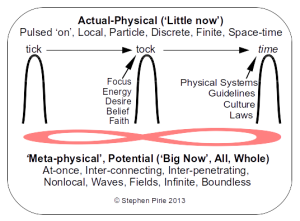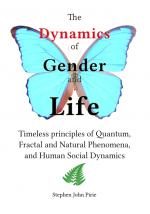[update, October, 2016: see below]
Over the years I've come to more fully appreciate the extent to which many people seek refuge in illusory ideals ... be it religious perfection, or scientific certainty.
As I've explained elsewhere on this and the Belief Institute website, the ideal of perfection (and of perfect scientific certainty) was born around the time of Plato, and has persisted ever since. In spiritual new-age teachings and practices, it's the seeking of spiritual perfection — of transcending one's ego and finding one's perfect higher self1; in religion it's the perfection of God and of the Pope's infallibility; in science it is the certainty and control of life expressed through some equation or theory, perhaps most tellingly exemplified by the incorrect and unsupportable assumptions surrounding the solutions to Zeno's Paradoxes that date back nearly 2,500 years.
In light of the enormous number of people who pursue these illusory outcomes (in religious, spiritual and scientific spheres), the pertinent question to ask is "Why?" Why pursue, or believe in that which does not exist?2 Two reasons, it seems to me: Firstly, insufficient focus or analysis. The ideal of perfection, in any sphere of human experience, including scientific research is easily countered and dismissed with sufficient consideration.3
But that of itself doesn't explain the pursuit of illusory ideals. There's a deeper driver that motivates the avoidance of the (reasonably straight forward) analysis and understanding. No, the second and major reason is that we chase illusory ideals because it provides a rest-stop for the developing psyche.
Like children who believe their parents are perfect, all-knowing and can do no wrong, our race is simply in the phase of not having yet developed sufficient confidence and maturity to dispense with such beliefs. Now, just as we don't chastise or look down upon children for their beliefs in Santa Claus or perfect parents, so too does it behoove us to recognize our racial immaturity (and that of religious, spiritual followers and scientists), as simply being a (passing) phase in our ongoing development. Where this understanding can be of great benefit is to bring some lightness (and creativity) to the world, by recognising that
although it appears comforting to believe in 'perfection', ultimately it is stultifying, repressive and 'heavy'.
The reasons are quite straight-forward: Perfection (in any area of life, including and especially scientific perfection4) leads to limited, fixed outcomes that restrict the natural creative flow of life. In overall terms, perfection requires a narrowing of choice5, and that narrowing brings with it a heaviness that smothers and stifles fun, frivolity, spontaneity, joy, learning, creativity, innovation, growth and happiness.6
Perfection requires a pinnacle of ascendancy, not the uplifting lightness and expanding enthusiasm and energy of growth, surprise and development.
Perfection, as can be seen of those who believe in it7, demands they forgo spontaneity, lightness and creativity, as spontaneity requires a 'letting go' of 'perfect' behaviours, outcomes, facts and theories.
For example, it's easy and a nice rest-stop to believe that a particular gene or group of genes is entirely responsible for some awkward social behaviour, such as shop-lifting or any number of other social taboos. All we need do is to pursue the 'perfect' understanding of the bits and pieces (genes, cells, organs) that comprise our bodies, in the hope that we'll find how to perfectly operate and control our body-machinery ... and those who misbehave.
There's only one problem with that fairy-tale ending. As the physicists in the field of quantum physics have known for some time, all of life, including the very stuff with which we think and feel, is bathed in, and deeply immersed in fluid nonlocal fields of ... wait for it, pre-physical possibilities.8 That richness to life — the fount of creativity, discovery, fun, surprise and love — cannot be squeezed into fixed, limiting boxes of perfection, or fully contained by any static representation of physical stuff.
But here's the kicker ... it's the scientists who are most caught and imprisoned by these illusory ideals. They don't (as a general rule) believe in the fluid potentials of all life, and of matter. They don't (yet) widely believe in the fundamental "physioplasticity" of the universe.
They don't accept that
"The enormous databases produced by PEAR provide clear evidence that human thought and emotion can produce measureable influences on physical reality."9
There are hardly any aspects to our current scientific, religious and spiritual belief-systems that aren't tainted with this heaviness.10 And that heaviness affects all of us, particularly those who are even remotely artistic or free-spirited.11
The cure for this heaviness of heart that we see in our sciences and religious institutions, is a good dose of institutional, cultural and personal spontaneity. Spontaneity requires that we don't know what might happen, but that "hell yeah, it might be fun," a learning experience, and many other things we can't fully know beforehand. Spontaneity, ironically, requires faith in that which is not yet physical. And it requires an intuitive appreciation that in the depths of spontaneity, there is layer upon layer of meaning, order and connection. Turtles all the way down the rabbit hole.
Spontaneity requires we get out of our heads, and follow our hearts. Falling in love is the art of spontaneity writ deep in our hearts. Falling into life is what we might now seek to do for the sake of ourselves, and our race. Stay tuned ... to your heart.
Update Monday, October 17, 2016
There's an additional reason to those mentioned above - the root dynamic of life is a cycle of rising potentials that are continually congealed into reality (see figure, right). The ideals that we seek, can be merely the completion of potential toward some desired reality. In effect the achievement is followed by a "letting go" (rest) phase during which new potentials are explored, then selected, built and realized (thus the cycle, ongoing). In that context, perfection is a momentary "realization" of some goal, or desired reality, which is eventually followed by further cycles of realization and growth. Even so, the term "perfect", which literally means complete, final, utter, absolute, by definition cannot be improved upon, which belies the ongoing development and complexity of life. A better term would be "it is what it is", and leave it at that. It's not perfect or imperfect, it is what it is.
As one might infer, a great deal of unhappiness can ensue for those seeking to "rest on their laurels" by hanging on to past achievements, particularly those achievements that may linger in time for longish periods (e.g. a built home, sporting successes/medals, wealth, etc). The root dynamic of life is one of change, growth — stretching to congeal new potentials into reality.
- 1. ... even worse than seeking one's supposed perfect higher self is the pursuit of Nirvana or 'oneness', a mindless state devoid of individuality. See "An ego by any other names still smiles like one".
- 2. See "What does 'holodynamic system' mean?" for the reasons why the idea of perfection is anathema to the endless creativity of the source of all.
- 3. The arguments with which to do so are available at this website and the Belief Institute website. See Related Content section below.
- 4. as showcased by the idea that parts, in the form of genes, cells and chromosomes, can 'perfectly' account for, or explain behaviour.
- 5. By definition, there can only be ONE perfect state; one perfect God, one perfect partner, one perfect career, answer, religion, book or perfect pious behaviour.
- 6. "Happiness is neither virtue nor pleasure nor this thing nor that but simply growth. We are happy when we are growing." William Butler Yeats.
- 7. Hence the typically serious, stern and strict (no dancing, music or frivolity) behaviours of many religious faiths.
Even the 'charismatic' church faiths that sing and dance and shout, are strict in scripture, belief and expected (sexual) behaviours.
- 8. "Everything that has already happened is particles, everything in the future is waves." [Sir Lawrence Bragg], Ronald W. Clark, Einstein, The Life and Times.
- 9. PEAR's Press Release Announcing Laboratory Closure
- 10. According to the World Health Organization, "Depression is the leading cause of disability as measured by YLDs" (YLDs = Years Lived with Disability).
- 11. There is evidence which "strongly suggests writers and artists show a vastly disproportionate rate of manic-depressive or depressive illness." Source: Janet Hawley, “Flying too high,” The Sydney Morning Herald, November 1, 1997, Good Weekend Section, page 26 {a review of Dr. Kay Jamison’s book Touched with Fire: Manic-Depressive Illness and the Artistic Temperament}.
